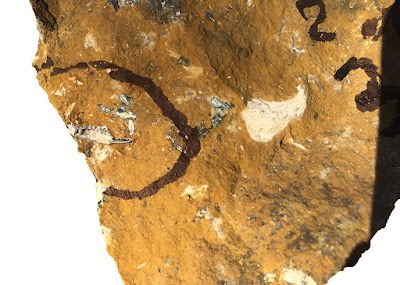 |
| Distoechurus jeanesorum |
Abstract
Four new fossil feathertail possum species (Marsupialia, Diprotodontia, Phalangerida, Petauroidea, Acrobatidae) are described from late Oligocene to middle Miocene fossil deposits in the Riversleigh World Heritage Area, northwestern Queensland. They are the first pre-Pleistocene fossil representatives of this family to be described. Two species are referred to the modern genus Acrobates and two to the modern genus Distoechurus. These species are distinguished from each other and from the living Distoechurus pennatus and Acrobates pygmaeus on the basis of qualitative and quantitative characters of the first lower molar (m1), which is the only tooth known for all four fossil species. Fortunately, m1 is morphologically the most variable tooth in the cheektooth row of acrobatids, and it exhibits numerous genus- and species-specific features. Phylogenetic analyses based on dental characters strongly support monophyly of Acrobatidae relative to other petauroids, as well as providing relatively strong support for reciprocal monophyly of Acrobates and Distoechurus, including the newly described fossil members of these genera. Recognition of species of Acrobates and Distoechurus in these fossil deposits is broadly congruent with recent estimates for the time of divergence of the two modern genera based on molecular data, and also provides an additional fossil calibration point for future studies of marsupial divergence times. These fossil species provide new insights into the biogeographical and ecological history of this enigmatic family of small possums, specifically that the oldest known species of Acrobates occurred in closed forest environments (in contrast to the living species, A. pygmaeus and Acrobates frontalis, which today inhabit open sclerophyll forests and woodlands) and that Distoechurus appears to have originated in Australia, only subsequently dispersing to New Guinea before becoming extinct in its Australian homeland.
Keywords: Possum, sacrobatids, Oligocene, Miocene, Riversleigh, Distoechurus, Acrobates
 |
| A rock from Riversleigh showing the fossilised teeth (left edge) of an ancestor of the feather-tailed possum. Credit: UNSW Sydney |
Systematic palaeontology
MARSUPIALIA Illiger, 1811
DIPROTODONTIA Owen, 1866
ACROBATIDAE Aplin (in Aplin & Archer), 1987
DISTOECHURUS Peters, Citation1874
Distoechurus jeanesorum sp. nov.
Diagnosis: This species, which is known from an isolated m1, differs from other fossil Distoechurus and Distoechurus pennatus in the following combination of features. In terms of occlusal area, it is approximately half the size of the m1 of the extant D. pennatus, and approximately 20–25% smaller than that of other fossil Distoechurus. The distinct difference between relative trigonid and talonid cusp heights seen in D. pennatus is not present. The entoconid is well developed and transversely flattened, whereas in D. pennatus this cusp is so reduced that it is barely distinct from the entocristid. The entoconid is more posteriorly situated than in other fossil Distoechurus, but less so than in D. pennatus. The protoconid is robust and does not exhibit the extreme, almost caniniform condition seen in other fossil Distoechurus and D. pennatus. The paracristid is present, whereas this crest is absent in D. pennatus. The bases of the protoconid and metaconid show a greater degree of confluence than in other fossil Distoechurus. The metacristid connecting the protoconid and metaconid is tall and well developed, in contrast to the condition in other fossil Distoechurus or D. pennatus, where this crest is indistinct or absent. The preentocristid is distinctly notched, whereas it is unnotched in D. pennatus. The trigonid is relatively narrow, with a more lingually positioned protoconid than in D. pennatus.
Etymology: Named in honour of Doug and Ann Jeanes, who have been substantial supporters of the Riversleigh Project, as well as enthusiastic volunteer field hands on field trips to the Riversleigh World Heritage Area, and to White Hunter Site in particular.
Conclusions:
The fossils described here provide the first fragmentary glimpse into the pre-Pleistocene evolutionary history and diversity of acrobatids, and indicate that the divergence between the two modern genera (Acrobates and Distoechurus) predates the Miocene. Discovery of more complete (cranial and postcranial) acrobatid material in fossil sites at Riversleigh or elsewhere has the potential to give major insights into other aspects of acrobatid biology, including the evolution of their uniquely derived auditory system (Aitkin and Nelson Citation, 1989; Aplin , ; Archer et al. Citation, 2019; Beck et al. Citation, 2022: character 62), and the precise timing of origin of gliding specializations in the Acrobates lineage.
Prudence R. Fabian, Michael Archer, Suzanne J. Hand and Robin M.D. Beck. 2023. First Known Extinct Feathertail Possums (Acrobatidae, Marsupialia): Palaeobiodiversity, Phylogenetics, Palaeoecology and Palaeogeography. Alcheringa: An Australasian Journal of Palaeontology. DOI: 10.1080/03115518.2023.2242439
https://phys.org/news/2023-10-feather-tailed-possums-guinea-aussies-fossil.html